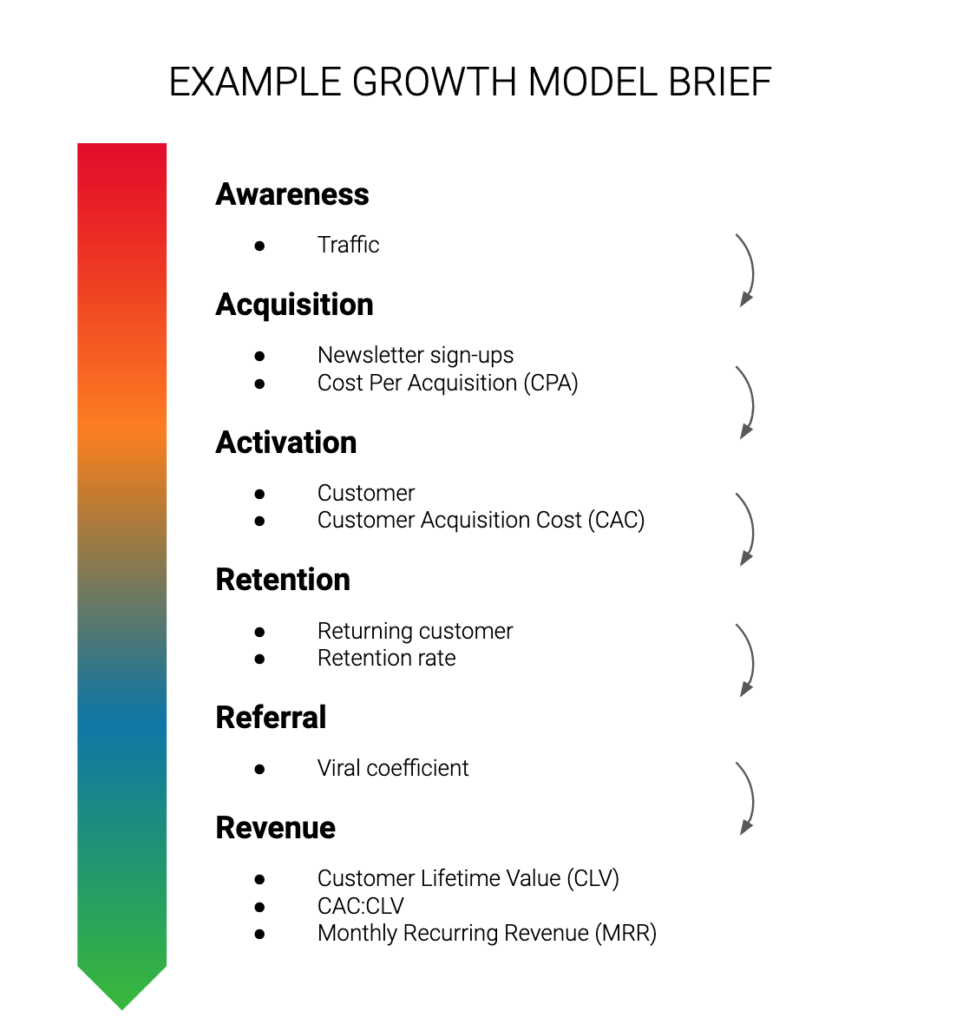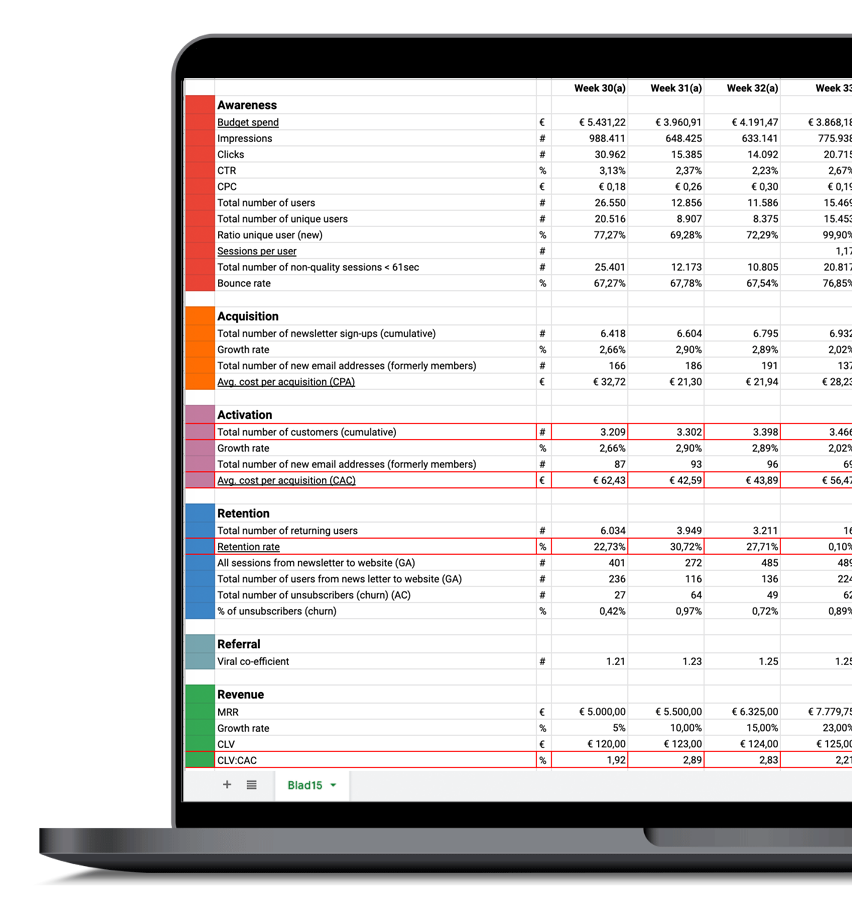Your startup offers an innovative product or service that is meant to make lives easier, help people achieve more and/ or provide solutions to complex problems. However, you will never get there if you don’t do your best to reach out to potential customers and convince them of your value proposition.
Realizing that growth isn’t just about hacking your way to the top of Google to drive all the traffic to your website, or reaching out to thousands of accounts a day on LinkedIn.
You need a solid, reliable model that will help you get there in a strategic way and realize growth by leveraging the ‘right’ marketing channels at the ‘right moment’.
In this article, we are going to talk about what a growth model is, why you need one and how you can create one for your business.
What is a growth model?
Simply put, a growth model is a strategy to maximize revenue and profit by focusing on acquiring new customers while retaining existing ones. You may even call it the North star of your growth efforts.
It can also be explained as the process of building a sustainable customer base that generates repeat revenue over time.
You can implement this by looking at what others have done before you who had similar goals and values or you can create one from scratch but adapt it along the way as needed for your specific business needs.
But in essence, the growth model consists of two elements – the marketing channel you choose will determine how you get your product/ service in front of potential customers, while the elements of your product/ service are what will convince them to buy from you. These two components work together to drive growth for your company.
But more importantly, a growth model is a process that makes your efforts towards growth measurable at each step of the marketing funnel. It involves the viewing of a dashboard that includes the most relevant metrics and how to connect each step in the customer’s buying journey, to lead them across the sales funnel until you secure a sale that gets added to the business revenue.
Why do you need a growth model?
A business lives and dies by its ability to grow, so having an effective growth strategy should be at the center of your business plan.
A growth model helps you understand how your customers will use your product or service, and what marketing channels you should focus on in order to drive adoption and sales.
Growth models lay down the framework of your strategy to ensure your startup’s growth. If a business model is the reason why customers buy your product or service, then a growth model explains how your company will attain new customers and scale.
This is because it loops in your stakeholders, marketing team, sales department, customer success managers, and even those looking into finances. It also helps you establish your ability to leverage your team’s strengths to create a concrete bottom line.
The purpose of a growth model is to enable you to understand where you are heading and what it takes to get there. A strong growth model consists of a few parts:
- The overall strategy for your business wherein you can create a workflow and a series of events that your marketing, sales, support and finance team can follow as you take your value proposition to the market.
- The channels that you need to focus on to reach your goals.
- The product and service elements that will help you acquire more customers.
How do you create a growth model?
To define your growth model, it’s critical that you have a complete understanding of your ideal customer profile and user journey map. If you haven’t done that yet, go back to the drawing board and create them first.
Or you could visit this guide from HubSpot on creating detailed customer personas to access their templates. They make for a good starting point that can be built on as you start to learn more about your audience!
Once you have those the foundational elements ready, you can start building out the rest of your growth model:
1. Define the individual steps of your funnel (i.e., Pirate Funnel)
The Pirate Funnel is a framework that helps growth hackers segment a company into 6 metrics of where they should focus their attention. Developed by Dave McClure, the Pirate Funnel is called so because of the first letters of the metrics to be observed. They are:
- Awareness
- Acquisition
- Activation
- Retention
- Revenue
- Referral
Finding the weaknesses in your business and more importantly, the reasons behind them can be extremely helpful in finding ways to improve your strengths. Pirate Funnels are a great way of evaluating what’s working and where the issues lie – almost like a SWOT analysis.
For example, a lot of visitors on your website did not take the action you wanted them to like signing up for your product. What would your next step be? Determining retention tactics like a signup discount.

2. Describe your metrics per funnel stage
The sales funnel is a concept that refers to the route that customers go through in order to become conversions. According to sales professionals, any given customer will enter your marketing funnel and as it progresses, they will move along and convert until they reach the gate at the end– becoming customers.
However, not all visitors will actually reach this point; many will drop off for any number of reasons before reaching their destination, which means that sales teams have to do something about it if they want the business to be successful.
Smart teams clearly define and then monitor their sales funnel metrics at each stage to help determine why visitors are dropping out. They aim to find out what causes this behavior leading them to start making adjustments until they produce better results.
3. Decide on the key metric(s)
To measure the success of your campaigns, you need to decide on key metrics. For example, is your campaign focused on converting leads? You may want to track the conversion rate. Are you looking to acquire new customers? Track your customer acquisition rate.
Having a data-driven approach will not only help your team remain on the same page and work towards the same goals but it will also make your success quantifiable and capable of future replication.
Also read: How to define your OKRs and success metrics.
4. Make forecasts based on assumptions and research
Creating an outstanding sales forecast can be a great way to help you to keep an eye on the future. It helps avoid unanticipated cash flow problems, with production, staff and financing needs.
A well-crafted system for sales forecasting based on research and even a few assumptions can minimize waste and provide several enormous long term benefits: resource allocation, cost control, risk management, and competitive analysis.
Forecasting your success teaches you to adapt quickly and stay ahead of things.

5. Learn and optimize on a weekly basis
While developing strategies and monitoring necessary metrics are an important part of growth, it is equally important to stay on top of your plan by regularly optimizing it.
Using the data at your disposal, you have the opportunity to evaluate exactly what’s being done in terms of your growth strategy and tailor it to fit future goals by tweaking it based on the analytics. Essentially, you’re implementing a continuous growth strategy that will only get better as tactics shift and goals change, becoming more efficient with each new learning experience.
How do you use a growth model?
A detailed growth model can be the ultimate hack to product improvement and business growth. But how do you use it? Let’s look at it here-
By tracking metrics
Each week, or even every day, you and your growth team look at important progress metrics to see if they match up with the goals you have set related specifically to your business growth. You can also compare them to see how far along in the right direction you are as a result of your previous predictions and the proactive strategies you worked on to get to your goal.
Comparing results with predictions
It is extremely important to continually check your results in comparison to the predictions you have made earlier. You can even keep updating your predictions three months in advance so that you can plan in advance and decide where to put your money or even to help you predict market movements.
Knowing if the results you are getting are in line with your predictions is a way to gauge the validity of your product. If you are shrewdly able to predict the graph of your success, you may be able to keep replicating your results to achieve exponential growth.
Focusing on certain sections of the funnel
If you receive results in sync with your predictions, great! It means you are on the right track. However, this may not always be the case. When you notice inconsistencies in your predictive analysis, the growth model will guide you on what part of the funnel you’ll need to focus more on.
Since predictive analysis essentially impacts your business’ bottom line by showing you the real picture of the demand for your product, market awareness, etc., an inconsistency should be tackled head-on.
When you break down your growth funnel and observe the metrics at each stage, you will be able to gauge where the leaks and your team can proactively start tweaking existing plans and devising new strategies to find solutions.
The secret here is adapting and being resilient at all stages of the marketing funnel.
Determining future steps
Once you know the results of your ongoing efforts, you can’t just stop there! Your team needs to focus on determining future steps regardless of the outcome. In case you are on the right track, this will help you sustain your growth and eventually help better the results. However, if you are not yet achieving the results you initially desired and forecasted, planning ahead will help you become more efficient and make better decisions.
Here’s how you can implement this-
- Understand your current market position
- Identify opportunities for the future
- Prepare for future expansion
- Keep reviewing your strategy
- Tweak it as required
Executing and looping back
Growth loops are a part of growth hacking, which is a system of rapid iteration driven towards identifying the quick wins that drive growth for startups. Growth hacking techniques can help startup ideas to identify these growth loops and take advantage of them before their competitors and stay ahead of the curve!
For example, if the way to increase growth in your business is by acquiring more customers through signups, then steps relevant to that particular goal should be taken within each growth cycle to attract new clients without fail.
The end of each growth cycle will be determined by reaching a milestone that serves as direction for the next growth loop– like getting 100 new customers. The next step then would be to get 100 more clients at no added cost and so the cycle continues reaching higher heights with each new trajectory.
This will eventually create a self-sustaining cycle that compounds exponentially with each step and can help lead your startup from seed to maturity if executed well.
Conclusion – You do need a growth model.
Finally, a good growth model is one that aims for real results, not just theoretical results that have no potential of being realized. Implementing the above shared information is a great starting point to incrementally improve your customer base and grow your business.




